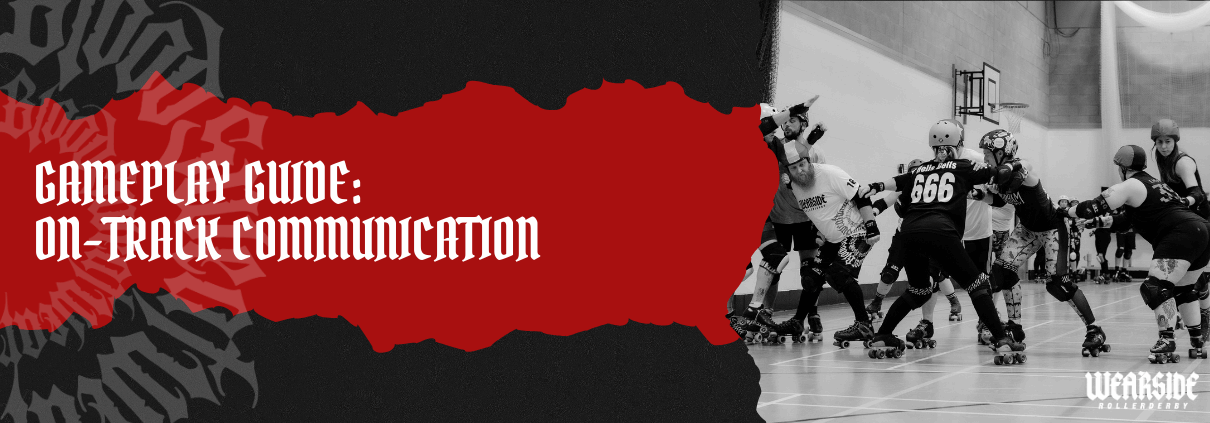Gameplay Guide: On-Track Communication
Anyone who’s seen a roller derby game will know that it can get pretty noisy.
The screech of the wheels, the toot of the whistles, the collective “oof” of the crowd when someone lands a particularly spectacular hit: all coming together in a beautiful cacophony of sound like no other.
But there’s one aspect of this symphony that’s especially important, and that’s the on-track communication.
While it may sound like discordant yelling from the outside, the communication that happens between teams during a jam is a crucial part of effective gameplay. Roller derby is a team sport. It’s also a fast-moving, often chaotic sport where knowing what’s happening, where, and to whom is a major advantage. And the best way to make sure everyone is on the same page is to talk to each other.
Communicating with your teammates on track and letting people know what’s going on around you means you can respond quickly, effectively, and collectively, putting you in the best possible position to make impactful moves.
Comms in action
Picture the scene. You’re a butt in a three-wall, and the jammer is doing their very best to move you and break through the seam. But if you don’t tell your teammates what the jammer is doing and where they’re focusing their efforts, they can’t help you push back. The jammer gets a shoulder in, knocks you out of the way, and flies off to net more points.
It doesn’t have to be this way! Enter the power of constant comms. This time, when the jammer is putting all their weight on your side of the wall, you’re going to communicate with your teammates.
“Jammer on me!”
Now your brace knows where the action is happening, they can offer more support. Your fellow butt can get lower and help you dig the jammer out. And as a wall, you’ll all know where the jammer is leaning in case they make a break for it.
That simple statement means your team is putting in the work where it’s most effective in that moment, and that they’ll be better prepared for whatever the jammer’s next move is.
Communication is just as vital in the moments before and after the jammer engages with the pack. When a jammer breaks through your wall, you need to catch them and reform as fast as possible—something that’s near-impossible to do without talking to each other.
Unless your team has developed some kind of psychic hivemind (in which case, please let us know how you did that), you’re going to need to communicate so you can reform quickly and cleanly.
How do you know what kind of wall you’re going to form? How do you know who’s going to brace? How do you know which side of the track the jammer is headed to?
If one of your blocks hasn’t caught up and you need to make do with a two-wall, tell your teammates. If you think you’re in the best position to take brace, tell your teammates. If you see the jammer moving towards the inside line, tell your teammates.
Building good habits
When there’s so much going on during gameplay, it can be hard to get out of your head and externalise what you’re seeing and experiencing. It’s especially hard when you’re new to the game and sometimes unsure of what on earth is happening around you. But the importance of communication absolutely can’t be understated, and getting into the habit of talking to your teammates will pay off massively, right now and in the long term.
Encouraging communication helps everyone play better, learn faster, and build a more cohesive team. To borrow a phrase from the British Transport Police: “See it. Say it. Sorted.”
A quick and dirty roller derby communication guide
To help you level up your on-track communication, we’ve put together a handy guide to some things you might hear during gameplay, what they mean, and how to respond.
- Five seconds: The jam is about to begin—get ready!
- Jammer on: The jammer is approaching the pack. Time to wall up, cover as much of the track as possible, and get ready to catch them.
- Close the seam: The jammer is about to make impact with the wall. Get low, and close the gap between butts nice and tight; shoulder to shoulder, elbow to elbow.
- On the inside/on the outside: The jammer is approaching on the inside/outside of the track. Get into position and cover the line so there’s no space for them to sneak through.
- Jammer on me: Your teammate is telling you that the jammer is pushing on them. Give them some extra support so they can stop the jammer from pushing through.
- Rotate: The jammer is trying to move around the wall. Rotate the three-wall to catch them without breaking the wall. (And remember to drop your arms as wall positions change!)
- Lost them: Your teammate is telling you that the jammer has broken past them or through the wall. Chase them and reform the wall while they’re still in the engagement zone.
- Wall up/reform: Find your fellow blockers and get back into your tripod/three-wall formation to prepare for another jammer pass.
- Wall on me/on me: Your teammate is telling you to reform the wall and that they’ll be brace. Get into position as a butt on whichever side you’re closest to.
- Bums on/butts on/suck back: Move back and take the jammer’s space by sitting on them to take away their wiggle room.
- Run them back/take them back: The jammer has been knocked out of bounds. Whoever is in the best position to do so should skate clockwise (anti-derby direction) and recycle them to the end of the engagement zone, causing them to lose their position on track.
- Push them out/knock them out: Your teammate is suggesting you try to hit the jammer out of bounds (usually when you’re close to the line).
- Offense: Your teammate wants you to run offense and help your jammer get through the pack by breaking up your opponents’ wall or getting in their blockers’ way.
- Power jam: One of the jammers has been sent to the penalty box, leaving only one jammer on track. This is likely to trigger a change in strategy, either to full offense if your jammer is the one left on track, or extra tight defense if the other team’s jammer is now the only one able to score points.
- No pack: The pack has broken up. Yield and reform the pack so play can continue.






Leave a Reply
Want to join the discussion?Feel free to contribute!